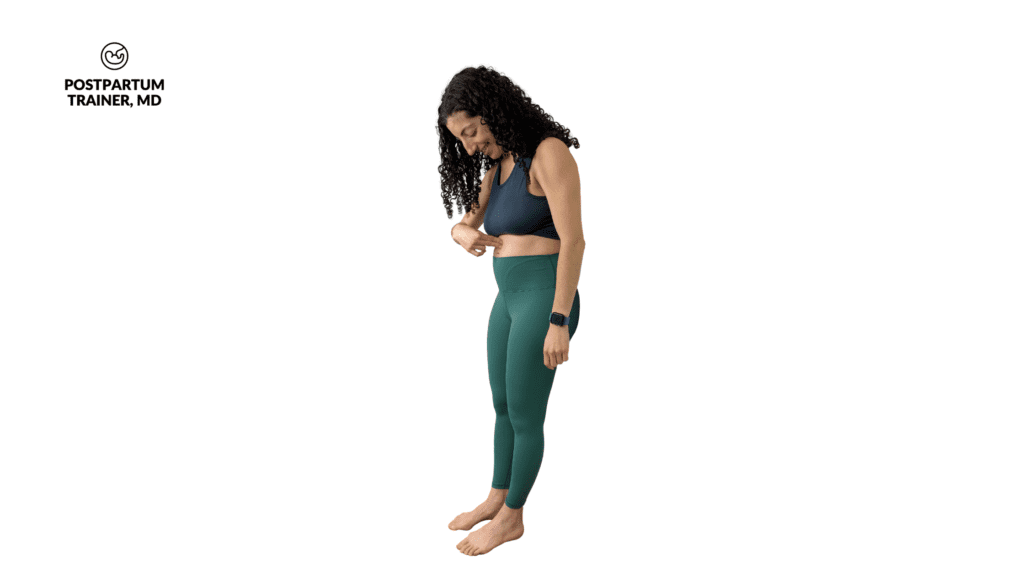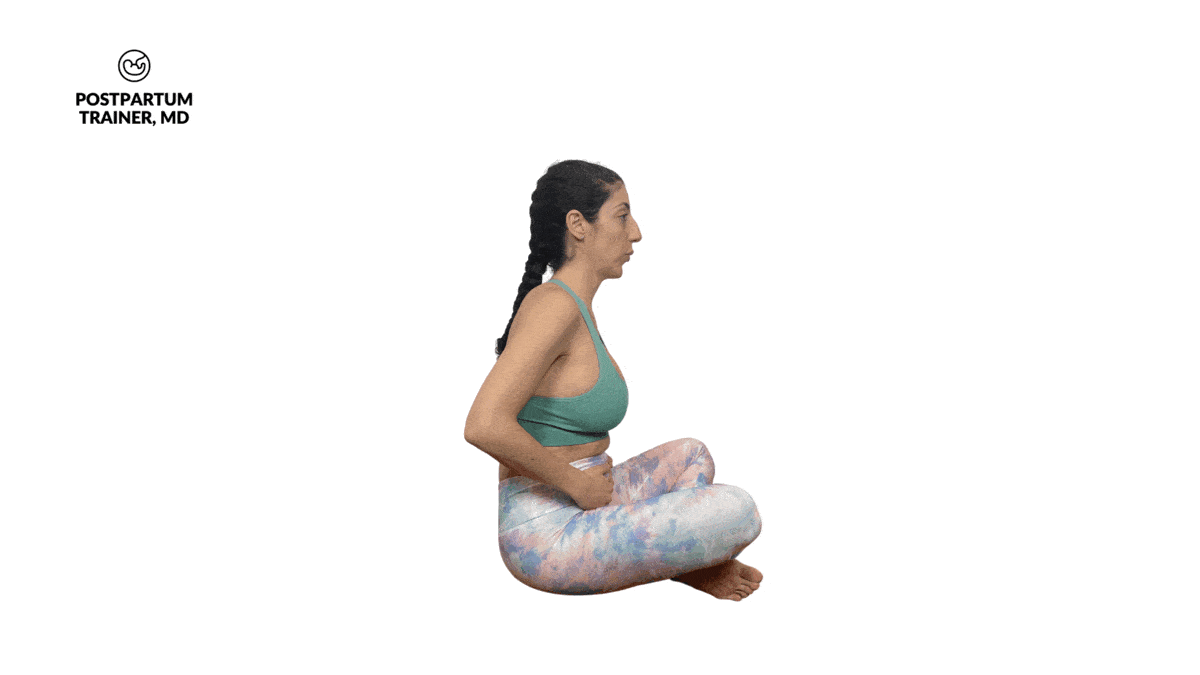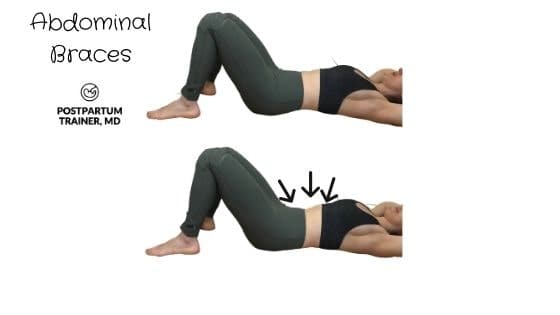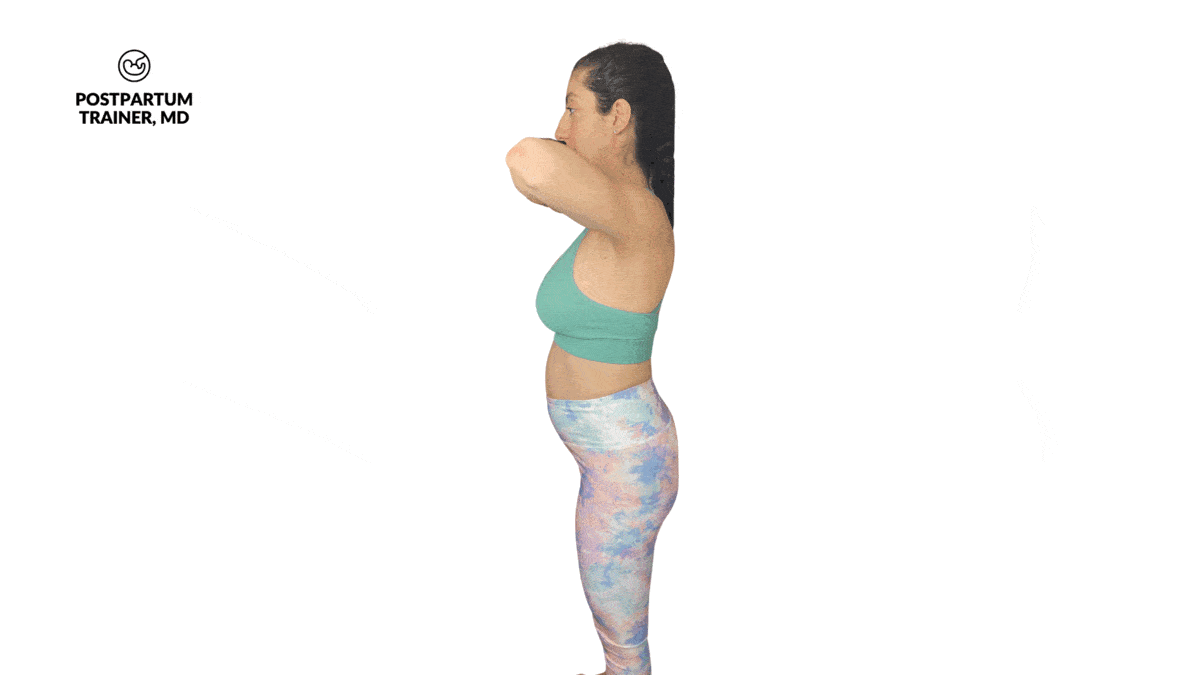What are the symptoms of diastasis recti?
In this post, you will learn:
- Common diastasis recti symptoms to know,
- What diastasis recti abdominis looks like, and
- The best exercises to start strengthening your core muscles safely.
Let’s get started.

What are the symptoms of diastasis recti?
The most common signs of diastasis recti include:
- A visible separation in the midline of your rectus abdominis muscles
- An obvious bulge in between the separation near your belly button
- Coning of your abdomen during abdominal exercises
Diastasis recti can also have associated symptoms due to a weak core, such as lower back pain, poor balance, and poor posture.
What does it look like?
Diastasis recti will look like a separation in the middle of your abdomen.
Imagine if someone has six-pack abs.
In diastasis recti, there will be a noticeable gap between the left and right rectus abdominis muscles.
You may also notice extra skin along the middle of the abdomen and a vertical bulge when performing core strengthening exercises.
![How To Tell If You Have Diastasis Recti [Everything You Need To Know] Cover Image](https://postpartumtrainer.com/wp-content/uploads/2022/04/How-To-Tell-If-You-Have-Diastasis-Recti-Everything-You-Need-To-Know-Cover-Image-225x300.png)
How do you know if you have diastasis recti while pregnant?
Knowing if you have diastasis recti while pregnant may be challenging, depending on which trimester you are in.
If you are still in the early second trimester, you can perform the modified curl-up test to check for diastasis recti while pregnant.

To do the modified curl-up test:
- Stand against a wall with your feet shoulder distance apart and about 12 inches from the wall.
- Curl your upper body around your belly.
- Press into the center of your abdominals using your index and middle finger.
- If you feel your fingers sinking into your core, and it feels squishy, you probably have diastasis recti.
Is it ever painful during pregnancy?
Diastasis recti in and of itself should never cause pain, especially during pregnancy.
You usually won’t even know you have the condition unless you specifically test for it, as it is difficult to see with your growing uterus.
What about severe diastasis recti? Are there severe symptoms?
There are no specific diastasis rectus abdominis symptoms; however, women with severe diastasis recti may have symptoms of a weakened core, including:
- lower back pain or discomfort,
- poor balance,
- difficulty getting out of bed or up from a chair,
- bad posture, or
- urinary incontinence (if you also have pelvic floor dysfunction)
Most experts define severe cases of diastasis recti as an abdominal separation of more than 5 centimeters.
How common is it? Does everyone get it in pregnancy?
Diastasis recti is a common condition and can occur in approximately 30-60% of women postnatally.
Most studies have noted that separation of the rectus muscles develops later in the pregnancy as the growing uterus places a lot of pressure on the abdomen.
But this does not mean every pregnant woman will get diastasis recti!
Does it go away?
Thankfully, research shows that diastasis recti can spontaneously heal in up to 70% of women.
Either way, almost all women will experience weakness in the core and benefit from strengthening the deep core muscles.
Can an Obgyn check for diastasis recti?
Yes, your OBGYN or health care provider can check for diastasis recti.
They can do a physical exam or send you for a targeted abdominal ultrasound.
However, it is probably best to check during the postpartum visit when the healing has already started.
Other Related Questions
How does diastasis recti happen?
Diastasis recti happens because the linea alba or connective tissue that holds the left and right rectus abdominis together stretches and weakens.
Most commonly, the linea alba is stretched by pregnancy.
During the second and third trimesters, your uterus undergoes rapid growth and development.
As the uterus enlarges, it stretches all the tissues around it, predisposing you to abdominal muscle separation.
What are common risk factors?
The most common risk factors for diastasis recti include:
- Multiple gestation pregnancy (twins, triplets, etc)
- Excess weight gain in pregnancy
- Having a big baby
- Having multiple pregnancies
Can diastasis recti happen in men?
Yes, diastasis recti can happen in men, especially those who are overweight and have a large belly.
Like pregnancy, the linea alba and rectus abdominis muscles get stretched and weaken.
Can diastasis recti happen without pregnancy?
Yes, diastasis recti can happen without ever being pregnant.
Newborn babies have diastasis recti as their abdominal muscles are fragile and have not yet been activated.
To simplify the matter, anything that causes weakening and stretching of the linea alba can lead to diastasis recti.
Can diastasis recti turn into a hernia?
Yes, it is possible to have an umbilical hernia with diastasis recti.
A hernia occurs when an organ or tissue protrudes through an abdominal wall defect or hole.
Learn more here- Diastasis Recti Vs Hernia: How To Tell The Difference.
Are there any diastasis recti exercises to help me fix it?
The good news is that there are many safe diastasis recti exercises you can do to help reduce your diastasis.
The key is to focus on exercises that target the transverse abdominis muscles while avoiding flexion-based exercises like crunches and sit-ups.
Here are my top three exercises to get you started.
Diaphragmatic breathing
Diaphragmatic breathing is one of the most fundamental exercises you can perform for diastasis recti.
It teaches you how to breathe using your diaphragm while activating your transverse abdominis muscles.

Here’s how to do it with proper form:
Sit in a comfortable position with your back straight.
Inhale and fill your abdomen with air. Try to expand your abdomen out anteriorly and out to your sides. Make sure you are not shrugging your shoulders as you are doing this. The only thing that should be moving is your abdomen!
Now exhale by squeezing your ab muscles together.
Let each inhale and exhale last 3 seconds.
Repeat five times.
Abdominal braces
The second exercise you should perform is the abdominal brace, which will help cinch and contract the muscles together.
It’s similar to diaphragmatic breathing, but you will hold the exhaled position.

To do this exercise:
Sit in a comfortable position with your back straight.
Exhale by drawing your belly button in and squeezing your deep abdominal muscles together.
Pretend as if you are bracing your abs before someone jumps on your belly.
As a bonus, try squeezing your pelvic floor muscle simultaneously. (Pelvic floor dysfunction is another common issue in the early postpartum period).
Hold this contraction for 5 seconds, then release.
Repeat five times.
Posterior pelvic tilts
The third exercise is the posterior pelvic tilt.
The pelvic tilt is one of my favorite exercises, as it is the basis for almost every core exercise that you can do.
It will also help you activate your pelvic floor muscles and reduce lower back pain.

To do this exercise:
You could either stand up against a wall or lie on your back with your knees bent and feet flat on the floor.
Now, try to bring your belly button down toward the wall or floor to flatten out your low back completely.
This position will naturally rotate your pelvis into a neutral position.
There shouldn’t be any arch in your low back!
Hold this position for 5 seconds and release.
Repeat five times.
So those are my top 3 diastasis recti exercises you can do to start building core strength safely.
Also, strengthening the core muscles before and during pregnancy is the only proven way to decrease your risk of developing diastasis recti.
Once you are cleared to work out and would like to improve core muscle strength further, check out my comprehensive list of 100 diastasis recti specific exercises and my 6-week exercise program.
Final Words on Diastasis Recti Symptoms
Although diastasis recti affect many postpartum and pregnant women, you don’t have to let it affect your quality of life!
Take control of your body and start rebuilding your core today!
There is a good chance you can fix it.
Now I want to hear from you.
Do you have diastasis recti? What symptoms did you experience as a result of your condition?
Comment below and let me know!
Related Posts:
